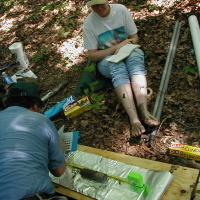
Michel Garey
Supervisors: Denise de Cerqueira Rossa-Feres, Célio F. B. Haddad, Marília Teresinha Hartmann, and Vinicius Xavier da Silva
Address: Instituto Latino-Americano de Ciências da Vida e da Natureza
Universidade Federal da Integração Latino-Americana (UNILA)
Av. Tarquínio Joslin dos Santos, 1000
CEP: 85870-901 - Jd. Universitário
Foz do Iguaçu, Paraná – Brasil.
Address: Instituto Latino-Americano de Ciências da Vida e da Natureza
Universidade Federal da Integração Latino-Americana (UNILA)
Av. Tarquínio Joslin dos Santos, 1000
CEP: 85870-901 - Jd. Universitário
Foz do Iguaçu, Paraná – Brasil.
less
Related Authors
Julian D Reynolds
Trinity College Dublin
Kristen J Gremillion
Ohio State University
David Seamon
Kansas State University
Jana Javornik
University of East London
Armando Marques-Guedes
UNL - New University of Lisbon
Nigel Andrew
University of New England - Australia
Kevin Arbuckle
Swansea University
Robert Foley
University of Cambridge
Gustavo Caponi
Universidade Federal de Santa Catarina - UFSC (Federal University of Santa Catarina)
Aravind N.A.
Ashoka Trust for Research in Ecology and the Environment (ATREE)
InterestsView All (8)










Uploads
Papers by Michel Garey
ence species composition at distinct scales. Previous
studies suggested that the distribution of larval anu-
rans at the landscape-scale is influenced by environmental gradients related to adult breeding site selection, such as pond canopy cover, but not by water chemistry. However, the combined effects of spatial, pond morphology, and water chemistry variables on metacommunity structure of larval anurans have not been analyzed yet. We used a partial redundancy analysis with variation partitioning to analyze the relative influence of pond morphology
(e.g., depth, area, and aquatic vegetation), water chemistry, and spatial variables on a tadpole metacommunity from southeastern Brazil. We predict that pond morphology and canopy cover will influence the metacommunity at broad spatial scales, while water
chemistry would play a larger role at finer scales. We found that broad-scale spatial patterns of pond canopy cover and pond morphology strongly influenced metacommunity structure, with water chemistry being not significant. Additionally, species composition was spatially autocorrelated at short distances. We suggest that the reproductive behavior of adult anurans is driving tadpole metacommunity dynamics, since pond morphology, but not water chemistry affects breeding site selection by adults. Our results contribute to the understanding of amphibian species diversity in tropical wetlands.
ence species composition at distinct scales. Previous
studies suggested that the distribution of larval anu-
rans at the landscape-scale is influenced by environmental gradients related to adult breeding site selection, such as pond canopy cover, but not by water chemistry. However, the combined effects of spatial, pond morphology, and water chemistry variables on metacommunity structure of larval anurans have not been analyzed yet. We used a partial redundancy analysis with variation partitioning to analyze the relative influence of pond morphology
(e.g., depth, area, and aquatic vegetation), water chemistry, and spatial variables on a tadpole metacommunity from southeastern Brazil. We predict that pond morphology and canopy cover will influence the metacommunity at broad spatial scales, while water
chemistry would play a larger role at finer scales. We found that broad-scale spatial patterns of pond canopy cover and pond morphology strongly influenced metacommunity structure, with water chemistry being not significant. Additionally, species composition was spatially autocorrelated at short distances. We suggest that the reproductive behavior of adult anurans is driving tadpole metacommunity dynamics, since pond morphology, but not water chemistry affects breeding site selection by adults. Our results contribute to the understanding of amphibian species diversity in tropical wetlands.